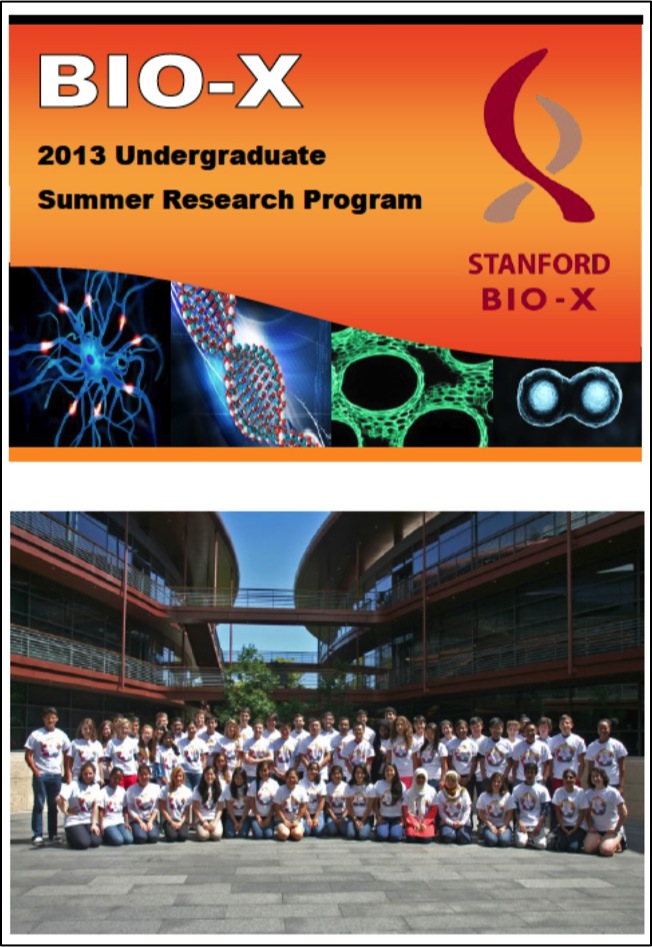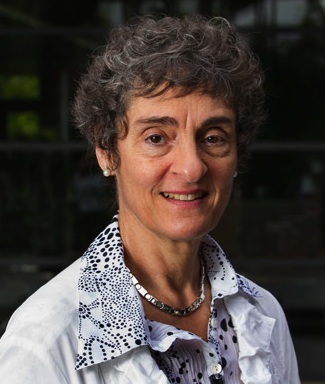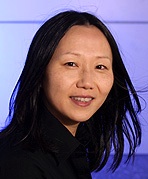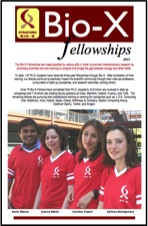
Welcome to the biweekly electronic newsletter from Stanford Bio-X for members of the Bio-X Corporate Forum. Please contact us if you would like to be added or removed from this distribution list, or if you have any questions about Stanford Bio-X or Stanford University.
Highlights
** On October 9, 2013, Bio-X celebrated the 10th Anniversary of the James H. Clark Center, the hub of Bio-X. Check out CLARK CENTER @ 10X on the SPLASH PAGE as well as the Bio-X Timeline over the last 15 years!!
** Check out the article by Stanford President John Hennessy in the Nov/Dec 2013 issue of the Stanford Magazine on Bio-X and the Clark Center, "A Cauldron of Innovation".
Seed Grants
 SEED GRANTS FOR SUCCESS - Stanford Bio-X Interdisciplinary Initiatives Program (IIP)
SEED GRANTS FOR SUCCESS - Stanford Bio-X Interdisciplinary Initiatives Program (IIP)
The Bio-X Interdisciplinary Initiatives Program represents a key Stanford Initiative to address challenges in human health. The IIP awards approximately $3 million every other year in the form of two-year grants averaging about $150,000 each. From its inception in 2000 through the fifth round in 2010, the program has provided critical early-stage funding to 114 different interdisciplinary projects, involving collaborations from over 300 faculty members, and creating over 450 teams from five different Stanford schools. From just the first 5 rounds, the IIP awards have resulted in a 10-fold-plus return on investment, as well as hundreds of publications, dozens of patents filed, and most importantly, the acceleration of scientific discovery and innovation.
In 2012, Stanford Bio-X selected 23 new seed grant projects as the winners of the 6th round. Please go here to view the list of awardees, along with the titles of their projects and the abstracts of the research. Competition was intense as the awardees were chosen from 118 Letters of Intent (LOIs). Selection criteria included innovation, high-reward, and interdisciplinary collaboration. (To view the 114 other IIP projects that have been funded from the first 5 rounds, please click here.) In addition, SANOFI has also funded 4 new Bio-X IIP Seed Grant projects from round 6!
We are cultivating and are highly successful in building meaningful collaborations with numerous corporate colleagues. New collaborations through our seed grant projects are highly encouraged. To learn about how to get involved, please contact Dr. Hanwei Li or Dr. Heideh Fattaey.
IIP Seed Grants-Related Events
** On Monday, March 3, 2014, Bio-X had a Poster Session, featuring 105 different posters from research by all scientists within the Stanford Bio-X community. Over 250 people attended the session, which allowed for an excellent venue to discuss science and research with colleagues from both academia and industry.
** On Monday, August 26, 2013, Bio-X had its second annual IIP Symposium of the year at the Clark Center, which highlights projects that exemplify the Stanford Bio-X mission of crossing boundaries to bring about interdisciplinary research and solutions in the field of life bioscience. The symposium was a huge success with over 300 people attending this event, which included 8 oral presentations and 136 poster presentations. Recorded talks from the symposium will be uploaded soon. If you'd like to view the talks for previous symposia through the years, please click here.
Fellowships
Every year, graduate students and postdoctoral scholars of Bio-X affiliated faculty are highly encouraged to apply for the Bio-X Fellowships, which are awarded to research projects that are interdisciplinary and utilize the technologies of different fields to solve different biological questions. Students are encouraged to work collaboratively with professors of different departments, thus creating cross-disciplinary relationships among the different Stanford schools. Our fellows have conducted exciting research, resulting in publications in high-impact journals and have been offered excellent positions in industry and academia. To date, Stanford Bio-X has a total of 152 Fellows.
On June 26, 2013, Bio-X held its annual Bio-X Fellows Symposium, where there were four 15-minute oral presentations followed by one-minute spiels from current fellows. The 25 newest fellows selected this year were also announced, and about 100 attendees came to the symposium. Please click on the "Bio-X Fellows Symposium" link above for the agenda and titles of the talks, and on the icon of the brochure above for the updated and latest Bio-X Fellowships brochure.
To view the numerous projects that have been awarded over the years, please click here.
 BIO-X UNDERGRADUATE SUMMER RESEARCH PROGRAM
BIO-X UNDERGRADUATE SUMMER RESEARCH PROGRAM
The Bio-X Undergraduate Summer Research Program supports undergraduate research training through an award designed to support interdisciplinary undergraduate summer research projects. The program is an invaluable opportunity for students to conduct hands-on research, learn how to carry out experiments in the laboratory, and develop the skills to read and analyze scientific literature.
This program is eligible to Stanford students who want to work in the labs of Bio-X affiliated faculty. To date, 241 students have been awarded the opportunity to participate in the Bio-X Undergraduate Summer Research Program. This summer is Stanford Bio-X's 8th round of USRP.
Participating undergraduates are also required to present poster presentations on the research that they've conducted during the program. Please click here for title lists of past posters that our undergraduates have presented.
Many fruitful collaborations and relationships have been established with industry through fellowships. Please contact Dr. Hanwei Li or Dr. Heideh Fattaey if you'd like to learn more about how to get involved with these fellowship programs.
News
 Stanford scientists discover a protein in nerves that determines which brain connections stay and which go
Stanford scientists discover a protein in nerves that determines which brain connections stay and which go
Bio-X Director Carla Shatz
A newborn baby, for all its cooing cuddliness, is a data acquisition machine, absorbing information to finish honing the job of brain wiring that started before birth. This is true nowhere more so than the eyes, which start life peering at a blurry world and within months can make out a crisp, three-dimensional image of a mobile dangling overhead. This process of refining the brain's wiring involves cutting off some of the excess nerve connections we have at birth while strengthening connections we use all the time. Some estimates show that as many as half of the brain's connections formed during development are clipped back as the final wiring takes shape. Carla Shatz, the David Starr Jordan Director of Stanford Bio-X, and her team, including postdoctoral researcher Hanmi Lee and Bio-X Graduate Fellow Jaimie Adelson, recently found a protein that is essential for the brain to remove those excess connections. The team specifically showed a role for the protein in the developing visual system in mice, but the work appears to apply broadly across the developing brain. They published their findings online March 30 in the journal Nature. Shatz said the discovery helps clear up something that has been a mystery to those who study brain development: How does the decision get made to eliminate some connections? It also settles a decade-long debate over whether the nervous system or the immune system is making those decisions. (Spoiler alert: It's the nervous system.)
Form of epilepsy in sea lions similar to that in humans, researchers find
Bio-X Affiliated Faculty Paul Buckmaster
California sea lions exposed to a toxin in algae develop a form of epilepsy that is similar to one in humans, according to a new study led by Stanford University School of Medicine researchers. Every year, hundreds of sea lions wash up along the California coast, suffering seizures caused by exposure to domoic acid, a neurotoxin that can produce memory loss, tremors, convulsions and death. Domoic acid is produced by algae blooms that have been proliferating along the coast in recent years, accumulating in anchovies and other small fish that the sea lions feed on, said Paul Buckmaster, PhD, DVM, professor of comparative medicine at Stanford. Buckmaster and his colleagues studied the brains of affected sea lions and found they had a pattern of damage in the hippocampus — the brain’s memory center — much like that in humans with temporal lobe epilepsy. “We found there was a loss of neurons in specific patterns that closely matched what is found in people,” he said. “And there is synaptic reorganization — a rewiring of surviving neurons. This also matches what is found in humans with temporal lobe epilepsy.” He said further studies in the animals could help in developing better treatments for them, as well as for their human counterparts. Buckmaster is lead author of the study, which was published online March 19 in the Journal of Comparative Neurology.

 Stanford engineers make flexible carbon nanotube circuits more reliable and efficient
Stanford engineers make flexible carbon nanotube circuits more reliable and efficient
Bio-X Affiliated Faculty Zhenan Bao and Yi Cui
Engineers would love to create flexible electronic devices, such as e-readers that could be folded to fit into a pocket. One approach involves designing circuits based on electronic fibers known as carbon nanotubes (CNTs) instead of rigid silicon chips. But reliability is essential. Most silicon chips are based on a type of circuit design that allows them to function flawlessly even when the device experiences power fluctuations. However, it is much more challenging to do so with CNT circuits. But now a team at Stanford has developed a process to create flexible chips that can tolerate power fluctuations in much the same way as silicon circuitry. "This is the first time anyone has designed flexible CNT circuits that have both high immunity to electrical noise and low power consumption, " said Zhenan Bao, a professor of chemical engineering at Stanford. The Bao Lab reported its findings in the Proceedings of the National Academy of Sciences. Huiliang (Evan) Wang, a graduate student in Bao's lab, and Peng Wei, a previous postdoctoral scholar in Bao's lab, were the lead authors of the paper. Bao's team also included Yi Cui, an associate professor of materials science at Stanford, and Hye Ryoung Lee, a graduate student in his lab.
Events
| Genetics April 2, 2014, 4 pm - 5 pm Clark Center Auditorium, Stanford, CA FRONTIERS IN BIOLOGY - Genome Engineering: Technologies and Applications Speaker: Feng Zhang, Broad Institute of MIT and Harvard Investigator |
Neurosciences Institute April 3, 2014, 12 pm - 1 pm Clark Center Auditorium, Stanford, CA "Understanding the levers of power in the brain: the biology of synapses and their control" Speaker: Timothy Ryan, PhD, Tri-Institutional Professor, Biochemistry, Weill Cornell |
| Immunology April 8, 2014, 4:15 pm - 5:15 pm Alway M106, Stanford, CA "The Multifaceted Functions of the PD-1 Pathways in Regulating T Cell Activation and Tolerance" Speaker: Arlene Sharpe, Harvard University |
Molecular Imaging Program @ Stanford (MIPS) April 10, 2014, 5:30 pm - 6:30 pm Beckman Building, Munzer Auditorium, Stanford, CA CCNE NANO-BIO SEMINAR SERIES: New Concepts in Biosensing using Single Walled Carbon Nanotubes and Graphene Speaker: Michael Strano, PhD, MIT |
Resources
| Stanford University |
| Stanford Bio-X |
| Bio-X Seed Grants The Stanford Bio-X Interdisciplinary Initiatives Program (IIP) provides seed funding for high-risk, high-reward, collaborative projects across the university, and have been highly successful in fostering transformative research. |
| Office of Technology and Licensing "Techfinder" Search the OTL Technology Portal to find technologies available for licensing from Stanford. |
| Stanford Center for Professional Development - Take advantage of your FREE membership! - Take online graduate courses in engineering, leadership and management, bioscience, and more. - Register for free webinars and seminars, and gets discounts on courses. |
| Stanford Biodesign Video Tutorials on how FDA approves medical devices A series of video briefs recently produced by the Stanford Biodesign Program teaches innovators how to get a medical device approved for use in the United States. This free, online library of 60 videos provides detailed information on the Food and Drug Administration regulatory process, short case studies and advice on interacting with the FDA. |
To learn more about Stanford Bio-X or Stanford University, please contact Dr. Hanwei Li, the Bio-X Corporate Forum Liaison, at 650-725-1523 or lhanwei1@stanford.edu, or Dr. Heideh Fattaey, the Executive Director of Bio-X Operations and Programs, at 650-799-1608 or hfattaey@stanford.edu.


